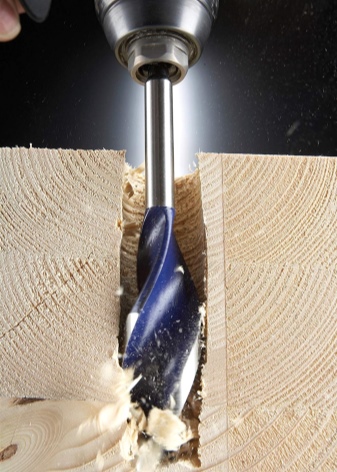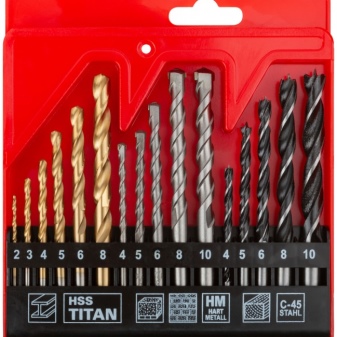Drills with countersink for wood

In the process of various construction activities, specialists often have to work with wooden structures. To make wood products look more aesthetically pleasing and not be spoiled by a large number of nails and screws, you can use special drills with countersinks when processing such material. Today we will talk about what important features these construction tools have and what types they can be.

Peculiarities
Wood countersink drills allow you to create and process holes in the material. At the same time, attachments of this type are small products that create recesses for wide mountings.
Countersinks for these tools are drills with several cutting components, they are most often used to work with holes of a tapered or cylindrical shape. Such metal elements make it possible to make depressions of different types in the material.
Also, a countersink drill is often used to slightly increase the diameter of the recess, to make machining of holes already made. The difference between the countersink tool and other models is that the first option uses more than two blades.
In addition, this tool is wider in diameter.


Often such attachments are needed for professional production machines. With this tool, many users carry out grinding of the holes made, processing the end of the structures, while hiding all the roughness and other irregularities on the surface.
The rest of the product is called the shank. This element is necessary to connect the tool to the chuck of a drill or machine tool. This part can also be of different shapes and sizes.
There are shanks of the following shapes: cylindrical, hexagonal, triangular, tetrahedral or canonical. In this case, the first option is the most common; it must correspond to the diameter of the cutting part. So, for a countersink with a larger diameter, a shank with a smaller diameter is used. For some of the smallest drills, shanks slightly larger than themselves may be selected.


The canonical shank is used commercially. All other varieties can only be used for certain types of chuck (three-jaw, conventional).
Any user will be able to make a countersink on his own, without buying at a hardware store. To do this, you first need to prepare an unnecessary self-tapping screw or a regular drill, such elements will become the basis for the future product. Then these parts should be trimmed slightly by adding a few thin blades.
Homemade designs can be customized, if necessary, for an individual configuration.
But, as a rule, hand-made nozzles wear out much faster compared to purchased models, and even small mistakes in manufacturing can lead to too large a diameter value.

Species overview
In hardware stores, buyers will be able to find a huge number of models of such tools with these attachments. These include the following samples:
- conical one-piece;
- mounted one-piece;
- cylindrical.
Each of them is used depending on what kind of hole you want to make in the wooden structure. For particularly laborious work, you can use such a slightly elongated nozzle.The latter version has small legs designed for trimming the ends of products. The best option for users would be to purchase a whole set with several varieties of such tools.



Cylindrical types of drills, as a rule, are covered with a special layer during the manufacturing process, which significantly increases the level of wear resistance of the product and its durability. The number of cutting parts can vary from 4 to 10. Externally, the design is similar to a conventional standard drill.
Besides, a special pin is placed at the end of the cylindrical models. This element is designed to fix the position of the tool itself during operation. Such products are equipped with limiters, they can be removable or act as a part of a whole structure.
Models with a removable drill depth stop are considered the most practical. They suggest the possibility of installing an additional cutting type attachment.


Removable versions are attached to the structure itself using small hidden screws. These stops are sometimes attached with a hex wrench.
If it is necessary to make several holes at once on one wooden product, while they must have the same depth, then it is better to use such drills that will be equipped with special holders with movable or fixed drilling stops.
Mounted conical drill model is a structure that works at a certain angle, the value of which will depend on the purpose of this model. The angle can be between 60 and 120 degrees. The number of cutting elements can be from 6 to 12 pieces.


The solid drill bit also looks like a conventional screw bit. It is most often used specifically for processing holes made in wood.
Various materials can be used for the production of countersinks. Most often in stores you can see such building elements made of various types of steel. So, they can be made from tool, alloy, carbon, high speed or carbide steel base.
If you need a drill to process various metal products, then carbide models may be the best option., because it is this variety that differs from all the others in its special resistance to constant loads.
For parts made of different types of wood, standard high-speed specimens will also be suitable.


Also countersinks for wood processing can differ in the diameter of the holes to be machined. The following options are considered the most common:
- standard models - the diameter will be from 0.5 to 1.5 mm;
- models for holes with a diameter of 0.5 to 6 mm - such samples can be produced with a safety device that will allow you to control the drilling depth;
- products for holes from 8 to 12 mm - this group, as a rule, includes special countersink drills with a shank.


Selection Tips
When buying a suitable version of such a drill, you should pay special attention to some aspects. Be sure to carefully look at the variety of the selected model.... If you need to make holes in wooden structures with a relatively small thickness or to process already created recesses on such products, then it is permissible to use samples with mounted countersinks. If you need to process massive objects or wooden parts with metal inserts, then it is already recommended to give preference to the cylindrical variety.
Also, before buying, it is better to pay attention to the material from which the sample is made. Some steel drill models can be the best option for long-term drilling requiring heavy loads, such as the carbide metal option. For work with thin wooden products that do not require much effort, such a tool should not be used. And some samples are designed for easier and faster drilling (HSS models).


For information on the types of drills with a countersink for wood, see the next video.













The comment was sent successfully.